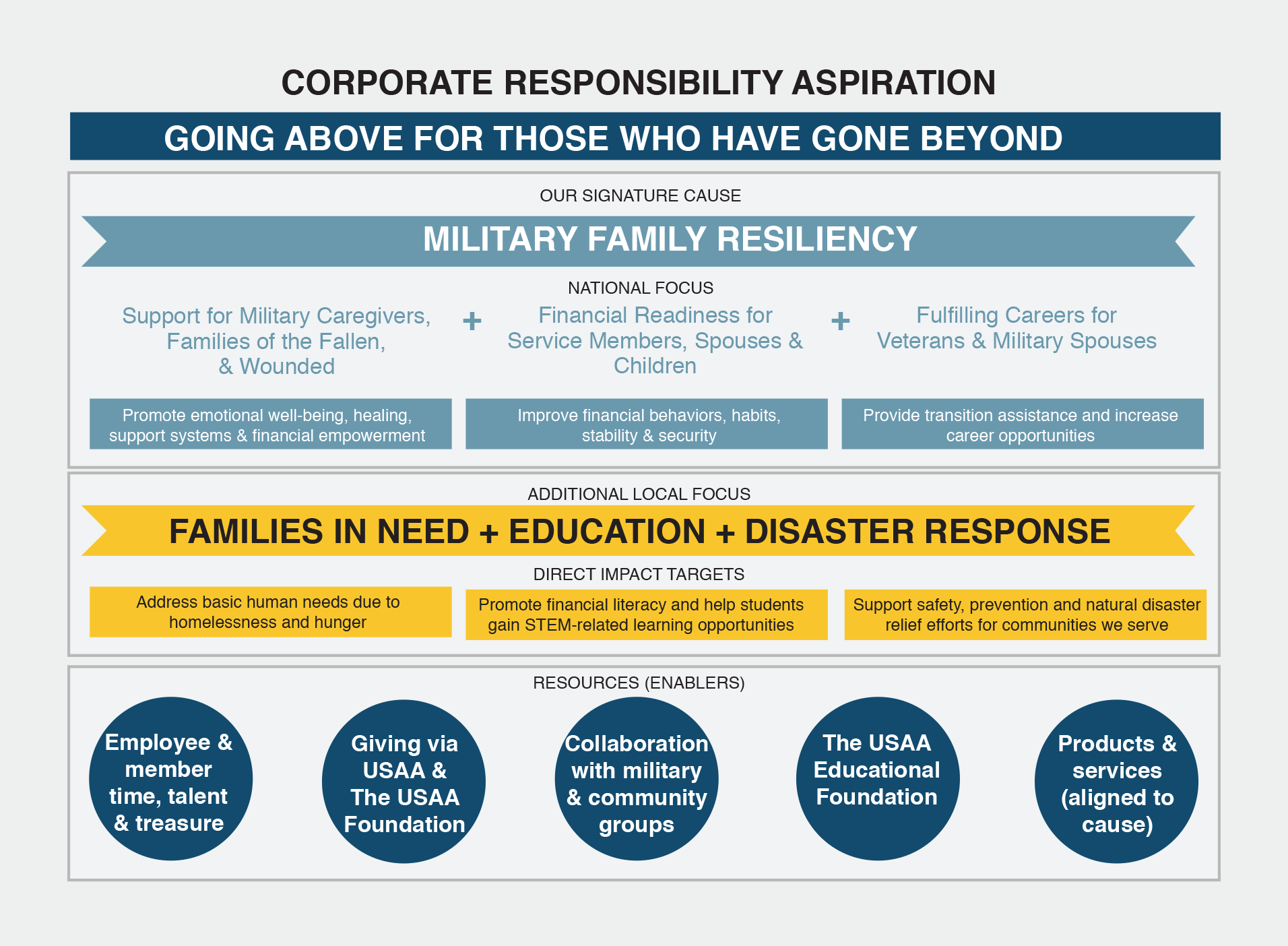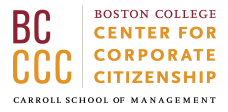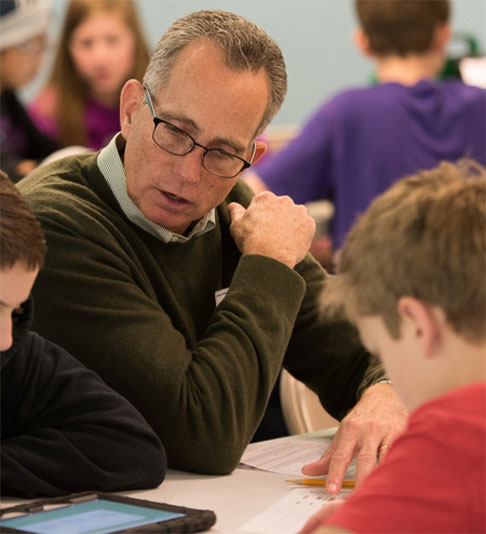Inspired Service
- Wed Jan 20 17:50:17 UTC 2016
- Katherine V. Smith
The following is excerpted from the Boston College Center for Corporate Citizenship’s most recent issue of the Corporate Citizen magazine.
|
|
| Jessica Allen, standing, is an Elizabeth Dole Foundation Fellow, serves as caregiver for her husband Charles, and holds down a job with the Yellow Ribbon Fund. While serving in Afghanistan, Charles stepped on an IED and everything changed—he became a double amputee. The Elizabeth Dole Foundation is one example of the nonprofits supported by USAA and The USAA Foundation to help military caregivers with programs that promote their emotional well-being and financial empowerment. |
With a new comprehensive corporate citizenship strategy, USAA sharpens its focus to increase positive impact on military families and local communities. In 1922, 25 Army officers in San Antonio, Texas, joined together to insure their automobiles because they had difficulty getting insurance due to their high-risk professions. These officers formed an insurance company to help protect one another—an association based on trust and the bond of military service.
From that humble beginning, the organization has grown to become a leading brand for customer experience. Today, USAA serves more than 11 million military servicemembers and their families with insurance, banking, investments, and financial advice. The organization’s corporate citizenship focus through the years had been broadly focused and mostly oriented toward its San Antonio hometown.
“USAA has long been an advocate for military families and a strong local corporate citizen,” said Stuart Parker, USAA’s CEO and a former Air Force pilot who flew combat missions during Operations Desert Shield and Desert Storm. “We knew we could have greater impact if we identified and focused on the areas of greatest need for military families and all of our local communities.”
Parker is carrying forward the vision of his predecessor, retired Army Major General Joe Robles, who sought to refine the company’s corporate citizenship strategy. The objective: increase USAA’s impact as a corporate citizen by sharpening its focus on needs aligned to its mission.
A Significant Opportunity
|
|
| Stuart Parker volunteers with students from military families at Junior Achievement Finance Park, a program designed to help youths understand the concepts and challenges of financial planning through classroom lessons and simulations of real-life budgeting scenarios. |
The opportunity to serve the military community is both significant and challenging. The roughly 200,000 men and women who take the U.S. military oath each year do so with unbridled pride, but their service to country comes with enormous challenges. For instance, in recent years approximately half of all post-9/11 servicemembers transitioning into civilian life have faced unemployment within 15 months of separation, and the unemployment rate among veterans is higher than that of nonveterans in most demographic groups.[i]
The gravity of these statistics is compounded by the forecast that 1 million veterans are expected to transition to civilian careers over the next five years, according to a Government Accountability Office report.[ii] Similarly, in Blue Star Families’ 2015 Military Families Lifestyle Survey, 75 percent of spouses married to an active-duty servicemember said being a military spouse had negatively impacted their ability to pursue a career.[iii]
Opportunities to help the military community also extend to the family members who support injured, ill, or wounded servicemembers. According to a 2014 RAND research report sponsored by The Elizabeth Dole Foundation, there are an estimated 5.5 million military caregivers today in the United States.[iv] Caregivers play an essential role in supporting wounded servicemembers and veterans. Yet this role can impose a substantial physical, emotional, and financial toll on families—and especially on the caregivers within them.
“Military families need help and support from the civilian community to help ensure financial stability in their futures,” said Harriet Dominique, USAA’s senior vice president of corporate responsibility and community affairs. “Our goal, quite simply, was to establish a research-based approach to corporate citizenship that was clearly aligned with USAA’s purpose and core values—with clear accountability for results.”
A Disciplined Approach

Dominique and Justin Schmitt, an assistant vice president on USAA’s corporate responsibility (CR) team, started the process to establish an enterprise citizenship strategy by working closely with the team responsible for the organization’s overall strategic plan. They engaged USAA’s internal research team and an external firm to conduct comprehensive research with their key stakeholders.
These efforts yielded insights about the areas its most critical stakeholders wanted USAA to focus on with its citizenship resources and programs.
To better understand the corporate citizenship landscape across the nation and identify potential gaps, USAA supplemented its stakeholder research in early 2014 by analyzing the citizenship strategies of 55 other companies spanning a variety of industries. One major gap that emerged at that time was support for military caregivers; the team saw a dire need and little attention being directed toward it from the corporate sector.
“It was essential for our citizenship strategy to strike a balance between the military and our local communities,” said Schmitt, who attended the Boston College Center for Corporate Citizenship’s Leadership Academy during 2013-14. “We wanted to approach the opportunity with humility and with an absolute focus on real results.”
To that end, Dominique, Schmitt, and the CR team developed and obtained senior leaders’ and the board’s approval of a future-state design of the strategy. With the help of a diverse employee “tiger team”— along with The USAA Foundation, Inc.,[v] and The USAA Educational Foundation[vi] —all philanthropic assets were repurposed to align with the new direction.
Strategy is Choice
USAA’s corporate responsibility strategy formalized Military Family Resiliency as its citizenship “signature cause,” with clear areas of focus to support both the military and local communities.
As USAA redefined its corporate citizenship strategy, the CR team made decisions about where they would increase their philanthropic commitments and what would be out of scope.
“This was challenging but ultimately very rewarding work,” said Schmitt. “Our team believed that strategy should be about what you do as well as what you don’t do—because prioritization is the only way to achieve a measurable and sustained impact.”
USAA’s commitments focus not only on supporting military families through philanthropic programs and volunteer opportunities for employees, but also on bringing greater attention to the needs of military families— thereby encouraging other corporations and foundations to get involved.
USAA’s corporate citizenship portfolio also includes a trio of priorities aimed at improving local communities as a whole, where USAA has physical, branded locations. These priorities include addressing basic human needs, particularly hunger and homelessness, as well as safety and disaster response, and STEM education to support the talent pipeline needed for USAA and its communities in the future.
Early Progress
USAA is moving forward with a transformational approach to support its new citizenship strategy. Among the highlights:
- Military caregivers, and families of fallen and wounded servicemembers: In 2015, USAA sponsored the Hidden Heroes Coalition Summit, a three-day event dedicated to caregivers who support wounded, ill, and injured military servicemembers and veterans. The event was hosted by the Elizabeth Dole Foundation in Washington, D.C. Also in 2015, USAA increased its support for the Tragedy Assistance Program for Survivors (TAPS), a nonprofit that offers compassionate care to all those grieving the death of a loved one serving in the U.S. Armed Forces. USAA’s annual Bowlathon in February 2015 saw more than 4,300 employees, retirees, and family members participate and raise more than $250,000 for TAPS.
- Financial readiness for military families: In both 2014 and 2015, Blue Star Families’ annual Military Family Lifestyle Surveys indicated military pay and benefits, and changes to retirement benefits as the top two issues of concern for servicemembers, military spouses, and veterans.[vii], [viii] Aligning with USAA’s redefined corporate citizenship strategy, The USAA Educational Foundation changed its purpose, transforming from a broad-based resource for materials on a multitude of consumer topics to an organization focused on improving financial readiness in the military and local communities. The Educational Foundation is currently working with the Association for Financial Counseling and Planning Education (AFCPE) to provide financial counselors who work with military servicemembers on installations throughout the United States with free, high quality financial readiness materials to help make a positive impact on the financial stability of military families.
- Veteran and military spouse hiring: USAA has continued its support for veteran and military spouse employment programs and veteran entrepreneurship initiatives. Since 2006, the enterprise has hired more than 10,000 veterans and military spouses into its workforce, and has partnered with companies such as Disney and General Motors to share best practices in an effort to encourage and help other companies hire and retain veteran employees. USAA recently was recognized as a 2016 Military Friendly® Employer by Victory Media, publisher of G.I. Jobs® magazine. This is the 13th consecutive year the company has ranked in the Top 10 on the annual list.
- Addressing homelessness: In late 2015, CEO Stuart Parker committed an initial investment of $2.1 million from USAA to local organizations participating in an effort to end veteran homelessness in San Antonio. Led by the White House Joining Forces Mayors Challenge to End Veteran Homelessness and supported by San Antonio city leaders, the initiative is part of a national campaign aimed at helping homeless veterans in more than 200 cities achieve housing stability.

Employee Engagement and Volunteerism
In 2015, nearly 93 percent of USAA’s workforce made a financial pledge to support the enterprise’s annual United Way campaign. Adding the pledges of USAA employees and retirees, and a contribution from The USAA Foundation, Inc., a record $13.4 million was raised.
For the first time, volunteerism was integrated with the United Way campaign to give employees a chance to experience an up-close-and-personal view of the impact of their pledges. During the two-week campaign period, more than 5,600 employees and retirees participated in volunteer events held on USAA campuses.
Parker equates community involvement and volunteering to other forms of personal development. In the fall of 2015, he announced USAA will provide all employees with “volunteer bonus hours”—in short, time away from work (two paid days off for most fulltime employees, per calendar year)—to allow employees to volunteer and give back to their communities.
“Volunteerism is a way all of us can make a difference in our communities,” Parker said. “When you volunteer, you help others, but often it’s you and your family that come away changed from the experience. I want our employees to have more opportunities to experience that.”
Marching Forward
The USAA team is confident in its progress, but is taking a long-term view to measure impact and will refine its measurement dashboard as it matures. The team plans to introduce its first CR Report in 2017.
“We’re on a five-year journey to increase our impact as a corporate citizen and the feedback that we’re getting from many key stakeholders in the military community, our local communities, as well as our employees and members, tells us we’re on the right track,” said Dominique. “We are at the beginning. We are confident in our team’s ability to execute and measure progress. The needs in our military and local communities require us to approach our priorities with discipline.”
[i] United States Department of Veterans Affairs. (2015). 2015 Veteran economic opportunity report. Retrieved from http://www.benefits.va. gov/benefits/docs/VeteranEconomicOpportunityReport2015.PDF
[ii] United States Government Accountability Office (GAO). (2014). Transitioning veterans: Improved oversight needed to enhance implementation of transition assistance program. Retrieved from http://www.gao.gov/assets/670/661361.pdf
[iii] Blue Star Families. (2015). 2015 Military families lifestyle survey. Retrieved from https://www.bluestarfam.org/resources/militaryfamily-lifestyle-survey
[iv]RAND Corporation. (2014). Hidden heroes: America’s military caregivers. Retrieved from http://www.rand.org/pubs/research_reports/RR499.html
[v] The USAA Foundation, Inc., a nonprofit organization, supports organizations that provide services in the areas of education, health and human services, arts and culture, and civic and economic development primarily in the communities where USAA employees live and work. The USAA Foundation, Inc., does not endorse or promote any commercial supplier, products or services. USAA is the sponsor of The USAA Foundation.
[vi] The USAA Educational Foundation, a nonprofit organization, does not endorse or promote any commercial supplier, product or service.
[vii] Blue Star Families. (2014). 2014 Military family lifestyle survey: Comprehensive Report. Retrieved from https://www.bluestarfam.org/ sites/default/files/media/stuff/bsf_report_comprehensive_reportfinal_single_pages.pdf
[viii] Blue Star Families. (2015).


